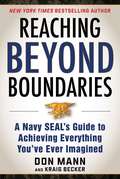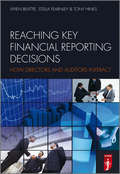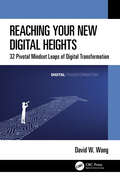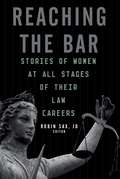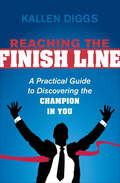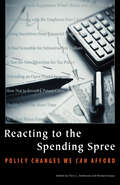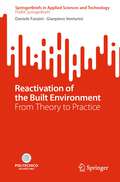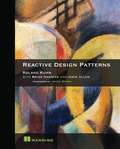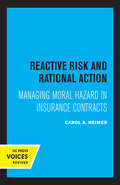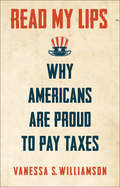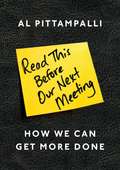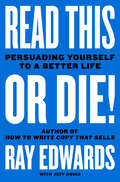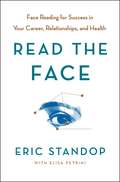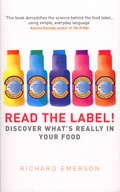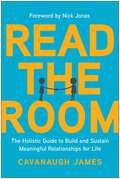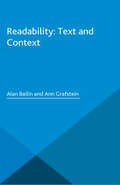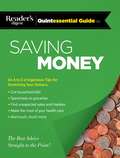- Table View
- List View
Reaching Beyond Boundaries: A Navy SEAL's Guide to Achieving Everything You've Ever Imagined
by Don Mann Kraig BeckerFor the last decade, decorated Navy SEAL, accomplished athlete, and bestselling author Don Mann has been traveling across the country giving motivational talks and in the process inspiring hundreds with the secrets behind his awe-inspiring achievements. In Reaching beyond Boundaries, Mann brings his much sought-after wisdom to the page. As an elite Navy SEAL, Mann performed seemingly impossible tasks on a regular basis. Here he details the lessons he learned from his training and shows how the rest of us can apply those teachings to our daily lives in terms of learning to push beyond our internal boundaries and achieve the goals we’ve set for ourselves, both professionally and personally. Reaching Beyond Boundaries teaches how to set and conquer both micro- and macro-goals through removing excuses, having the right mindset, and learning from successes and failures. Making your dreams a reality is possible. With Reaching Beyond Boundaries you can begin to realize your fullest potential today.
Reaching Beyond Your Organization: Empowering Innovation
by William R. KerrForward-thinking established companies utilize new routes for external innovation with start-ups and crowds. The reading reviews strategic partnerships, strategic investments, strategic acquisitions, and crowd-based collaborations. Case examples include Google, SK Telecom, DaVita, UPS, and GSK. The note can be paired with Core Reading: Leading Breakthrough Innovation in Established Companies (#5272).
Reaching Key Financial Reporting Decisions
by Tony Hines Vivien Beattie Stella FearnleyThe regulatory framework for financial reporting, auditing and governance has changed radically in recent years, as a result of problems identified from the Enron scandal and more recently from the drive to implement global standards. In a key regulatory change, a company audit committee is now expected to play a significant role in agreeing the contents of the financial statements and overseeing the activities of the auditors. Finance Directors, Audit Committee Chairs and Audit Engagement Partners are required to discuss and negotiate financial reporting and auditing issues, a significant process leading to the agreement of the published numbers and disclosures, and to the issuing of the auditor's report which accompanies them, but which is entirely unobservable by third parties.Reaching Key Financial Reporting Decisions: How Directors and Auditors Interact is a fascinating, behind-the-scenes examination of this closed process. The authors draw on the results of face to face interviews, and an extensive survey of finance directors, audit committee chairs and audit partners, and present nine company case studies highlighting the process of discussion and negotiation and the methods by which the agreed financial reporting outcome was reached. Detailed analysis of the case studies:Allows those involved in the process to benchmark their behaviours against those of othersEnables a comparison between the previous and current regulatory environments to see what has changed, and sheds light on the sorts of behaviours the current regulatory framework encouragesEvaluates the effectiveness of the changed regulatory regime, providing evidence relevant to current policy debates concerning the value of audit, IFRS and the relative merit of rules-based versus principles-based accounting standards in relation to professional judgement and complianceThe unprecedented access and unique insights offered by this book make it invaluable for audit firm staff and partners, audit committee chairs and company directors involved in agreeing the published financial statements, as well as those who have an interest in the financial statements, but do not have access to the negotiation process.
Reaching Your Goals Through Innovation (Management Extra Ser.)
by ElearnThis series fuses key theories and concepts with applied activities to help managers examine how they work in practice. The books are created with individuals in mind and are designed to help improve management skills. Management Extra can also be used in conjunction with management programmes of study aligned to standards. Each of the books has case studies, self assessments and activities all underpinned by knowledge and understanding of the frameworks and techniques required to improve performance. Management Extra provides managers and trainers with a handbook for action and development. This book explores the concept of spotting good ideas, linking them to the business context and making them work. In doing so you will be reaching, achieving and even exceeding your goals. Key objectives are: to use objectives and goals to help you set direction and monitor outcomes for you and your team; review the organisational context for innovation and how to make things happen; understand the characteristics of successful innovators and your role in championing opportunities for innovation
Reaching Your New Digital Heights: 32 Pivotal Mindset Leaps of Digital Transformation
by David W. WangThe 4th Industrial Revolution is here, and it is the catalyst of our mindset changes as we are facing a new world of digital transformation. Mindset stands for our outlook, attitudes, and behaviors toward the world. Now that the world is rapidly changing due to technological advances, our mindset needs to leap with the trend and enable us to excel in the new digital era. Many books may have touched on the subject of digital mindset but this book takes it to a new level. The new Cognitive Model of Digital Transformation, introduced in and followed by this book, is dedicated to digital mindset leaps from key concepts and comparative approaches to best practices. The Cognitive Model of Digital Transformation categorizes the process of digital mindset leaps into five different layers, from Layer 1 as the foundation or starting key concepts, Layer 2 for digital ways of thinking, Layer 3 on digital behaviors and capabilities, Layer 4 on digital transformation, all the way to Layer 5 of wisdomin digital space, walking through the entire journey of digital mindset leaps. This book intends to help get your mindset adapted and ready to navigate digital transformation along the right track. Enjoy this book and its amazing journey of digital mindset leaps.
Reaching and Changing Frontline Employees
by Sandar Larkin T. J. LarkinPlanning a major change in your organization? If so, chances are you have arranged a huge rally, rousing speeches, videos, and special editions of the company paper. Stop. This sort of communication is not working. If you want people to change the way they do their jobs, you must change the way you communicate with them. Drawing on their own research and the research of other communication experts from the past two decades, the authors argue that senior managers--and most communication consultants--have refused to hear what frontline workers have been trying to tell them: When you need to communicate a major change, stop communicating values, communicate face-to-face, and spend most of your time, money, and effort on frontline supervisors.
Reaching the Bar
by Robin SaxWomen account for 30% of the 1.14 million attorneys currently practicing in the U.S., and in 2007, 48% of all juris doctor degrees were awarded to women. Despite the growing appearance of women at the bar, the law is still a profession dominated by older white men. While some of the challenges an aspiring lawyer faces are the same regardless of gender, other issues are particular hurdles for woman attorneys. Reaching the Bar provides the perspectives of women lawyers to their peers and to women just getting started in their legal careers. From their first torts class to their final case studies, women at law have to make choices about what specialty degrees to pursue, whether or when to have children, and how they are going to respond to sexism in the workplace and the courtroom. These books provide a forum for women at all levels to describe and examine those choices Reaching the Bar features stories from each stage of a lawyer's career - beginning with the law school students and clerks, through the corporate stages from junior associate to senior partner, then on to late-stage careers like judges or professors. Reaching the Bar blends inspirational, funny and dramatic stories, with the constant theme of seasoned women looking back at their experiences and sharing what they've learned.
Reaching the Finish Line: A Practical Guide to Discovering the Champion in You
by Kallen DiggsWhat&’s holding you back from your goal? Most people are stuck in their jobs due to a lack of faith in their potential. Reaching the Finish Line shares research and discoveries on what hinders people from meeting their goals and what people can do to become successful achievers. You will learn: * How to Find a Great Career Without a High School Diploma * How to Graduate with a Bachelor&’s Degree in One Year * How to Change Careers Without Going Back to College * How to Work from Home for the Rest of Your Life * How to Make a Six-Figure Salary in Real Estate Without a License or Prior ExperienceReaching the Finish Line includes in-depth chapters covering a variety of career options based on your preferences and current situation. If you have always wanted to become the person that you dreamed about, look no further—this is the book that can make the difference.
Reacting to the Spending Spree: Policy Changes We Can Afford
by Terry L. Anderson Richard SousaA team of expert contributors analyze the near- and long-term implications of efforts by both the Obama and Bush administrations to fix the current financial crisis. They examine a range of issues affected by the proposed reforms, including health care, "going green," the Employee Free Choice Act, an open world economy, and more.
Reactions to the Market: Small Farmers in the Economic Reshaping of Nicaragua, Cuba, Russia, and China (Rural Studies)
by Laura J. EnríquezIt is manifest in developing countries around the world that the “shock” therapy administered to their economies by the neoliberal model of structural adjustment has failed, leaving much social and economic destruction in its wake. In Latin America this failure has led to a resurgence of interest in alternative models, some of them deploying various versions of socialism, as in Bolivia, Chile, and Venezuela, which has given rise to talk about the new “pink tide” enveloping the region. In this comparative study of four economies that have been making a transition to the market from their orthodox socialist pasts, Laura Enríquez focuses our attention on the plight of the small farmer in particular and on the importance of this sector for the overall socioeconomic success of the transition. Through this comparison, we see the similarities between Nicaragua and Russia in their rapid retreat from socialism and their adoption of reforms that have placed small agriculture, especially that focused on food crops, at a distinct disadvantage relative to export-oriented production. By contrast, Cuba has been more like China in adopting aspects of market reform while emphasizing small-scale cooperative and private farming in an effort to achieve food self-sufficiency. Drawing insights from Karl Polanyi’s study of the social and economic effects of the expansion of market relations in the nineteenth century, Enríquez highlights the role of the state in each of these countries in driving change in a certain direction: toward de-emphasis of small-scale farming and the eventual assumed demise of the peasantry in Nicaragua and Russia, which has led to countermovements of peasants struggling to survive, and toward the reconfirmation of the value of small farming in contributing to balanced economic development in Cuba and China.
Reactivation of the Built Environment: From Theory to Practice (SpringerBriefs in Applied Sciences and Technology)
by Daniele Fanzini Gianpiero VenturiniThe book deals with urban reactivation, a particular form of regeneration intervention which in addition to the physical-spatial dimension of the places also—and above all—considers the social and relational dynamics that the intervention is able to activate. In this sense, the concept of activation (or reactivation) emphasizes the act of putting something into or back into operation, whether it concerns the material components of a container (a building or a place) or the immaterial components of a content (a need, or a function), starting from the exploitation of opportunities that the architectural project contributes to revealing, developing and accompanying.
Reactive Design Patterns
by Jamie AllenSummaryReactive Design Patterns is a clearly written guide for building message-driven distributed systems that are resilient, responsive, and elastic. In this book you'll find patterns for messaging, flow control, resource management, and concurrency, along with practical issues like test-friendly designs. All patterns include concrete examples using Scala and Akka. Foreword by Jonas Bonér. Purchase of the print book includes a free eBook in PDF, Kindle, and ePub formats from Manning Publications.About the TechnologyModern web applications serve potentially vast numbers of users - and they need to keep working as servers fail and new ones come online, users overwhelm limited resources, and information is distributed globally. A Reactive application adjusts to partial failures and varying loads, remaining responsive in an ever-changing distributed environment. The secret is message-driven architecture - and design patterns to organize it.About the BookReactive Design Patterns presents the principles, patterns, and best practices of Reactive application design. You'll learn how to keep one slow component from bogging down others with the Circuit Breaker pattern, how to shepherd a many-staged transaction to completion with the Saga pattern, how to divide datasets by Sharding, and more. You'll even see how to keep your source code readable and the system testable despite many potential interactions and points of failure. What's InsideThe definitive guide to the Reactive ManifestoPatterns for flow control, delimited consistency, fault tolerance, and much moreHard-won lessons about what doesn't workArchitectures that scale under tremendous loadAbout the ReaderMost examples use Scala, Java, and Akka. Readers should be familiar with distributed systems.About the AuthorDr. Roland Kuhn led the Akka team at Lightbend and coauthored the Reactive Manifesto. Brian Hanafee and Jamie Allen are experienced distributed systems architects. Table of ContentsPART 1 - INTRODUCTIONWhy Reactive? A walk-through of the Reactive Manifesto Tools of the trade PART 2 - THE PHILOSOPHY IN A NUTSHELLMessage passing Location transparency Divide and conquer Principled failure handling Delimited consistency Nondeterminism by need Message flow PART 3 - PATTERNS Testing reactive applications Fault tolerance and recovery patterns Replication patterns Resource-management patterns Message flow patterns Flow control patterns State management and persistence patterns
Reactive Power Support Using Photovoltaic Systems: Techno-Economic Analysis and Implementation Algorithms (Springer Theses)
by Oktoviano GandhiWith the widespread adoption of photovoltaic (PV) systems across the world, many researchers, industry players, and regulators have been exploring the use of reactive power from PV to support the grid. This thesis is the first to comprehensively quantify and analyse the techno-economic cost and benefits of reactive power support using PV. On top of formulating the cost of PV reactive power and identifying the feasible range of its monetary incentives, this thesis has also proposed practical methods to implement the reactive power dispatch effectively and efficiently, with and without communication infrastructure. The findings and approaches in this work can therefore help power system planners and operators towards better integration of PV into the electrical grid, both in terms of regulation and implementation.
Reactive Risk and Rational Action: Managing Moral Hazard in Insurance Contracts (California Series on Social Choice and Political Economy #6)
by Carol A. HeimerThis title is part of UC Press's Voices Revived program, which commemorates University of California Press’s mission to seek out and cultivate the brightest minds and give them voice, reach, and impact. Drawing on a backlist dating to 1893, Voices Revived makes high-quality, peer-reviewed scholarship accessible once again using print-on-demand technology. This title was originally published in 1985.
Read My Lips: Why Americans Are Proud to Pay Taxes
by Vanessa S. WilliamsonConventional wisdom holds that Americans hate taxes. But the conventional wisdom is wrong. Bringing together national survey data with in-depth interviews, Read My Lips presents a surprising picture of tax attitudes in the United States. Vanessa Williamson demonstrates that Americans view taxpaying as a civic responsibility and a moral obligation. But they worry that others are shirking their duties, in part because the experience of taxpaying misleads Americans about who pays taxes and how much. Perceived "loopholes" convince many income tax filers that a flat tax might actually raise taxes on the rich, and the relative invisibility of the sales and payroll taxes encourages many to underestimate the sizable tax contributions made by poor and working people.Americans see being a taxpayer as a role worthy of pride and respect, a sign that one is a contributing member of the community and the nation. For this reason, the belief that many Americans are not paying their share is deeply corrosive to the social fabric. The widespread misperception that immigrants, the poor, and working-class families pay little or no taxes substantially reduces public support for progressive spending programs and undercuts the political standing of low-income people. At the same time, the belief that the wealthy pay less than their share diminishes confidence that the political process represents most people.Upending the idea of Americans as knee-jerk opponents of taxes, Read My Lips examines American taxpaying as an act of political faith. Ironically, the depth of the American civic commitment to taxpaying makes the failures of the tax system, perceived and real, especially potent frustrations.
Read This Before Our Next Meeting
by Al PittampalliFinally available in bookstores, an accessible guide on making meetings more effective, efficient, and worthy of attendingIf an operating room were as sloppily run as our meetings, patients would die. If a restaurant kitchen put as little planning into the meal as we put into our meetings, dinner would never be served. Worst of all, our meeting culture is changing how we focus, what we focus on, and what decisions we make. But there is an answer. A new kind of meeting--the Modern Meeting. Starting today, that's how we're going to do business. Culture change occurs when a transformational idea spreads to enough people. Like a virus that makes its way from person to person, spreading exponentially faster, so can the Modern Meeting and its seven critical principles of effective meeting management. Pittampalli shares examples of transforming workplaces by revamping the purpose of the meeting and a company's meeting culture. Simply put, he wants companies to stop wasting time. Read This Before Our Next Meeting is a call to action employees and their bosses need to create companies that do meaningful work. The status quo must go. Now. Before it's too late.
Read This or Die!: Persuading Yourself to a Better Life
by Jeff Goins Ray EdwardsDiagnosed with a terminal illness, a leading marketing consultant discovers that what he has learned about persuading others might help him save his own life. Ray Edwards was one of the top marketers and copywriters in the business with A-list clients like Tony Robbins, Jack Canfield, and Michael Hyatt when he was diagnosed with Parkinson’s. The diagnosis brought his life to a screeching halt and propelled Edwards to question everything he thought he knew about his Christian faith, his relationships, what kind of person he was, and how the world worked.Out of options and deeply depressed, Edwards decided he needed to turn his life around or die a failure. He had to let go of false beliefs and find better ones. To his surprise, he found that the principles of persuasion he’d honed for over four decades to move others could work for him. In the vein of The Last Lecture and Tuesdays with Morrie, Read This or Die! Is the tale of one man’s transformation and how he achieved it.Edwards outlines the powerful, time-tested PASTOR process he created that helped him identify and untangle the beliefs that were holding him back and provided a game plan for how to change his life:Pain: start with what hurtsAmplify: determine how it will get worse before it gets betterStory: find the story of a better futureTransformation: choose the evidence worth believingOpportunity: discern where change can happenResponse: set up a system that makes transformation stickFor anyone who wants to turn their life around but does not know how, the PASTOR method teaches how to harness marketing wisdom to get honest about what we really want from life and craft better beliefs and plans to help us start living life on our own terms.
Read Write Own: Building the Next Era of the Internet
by Chris DixonThe internet of today is a far cry from its early promise of a decentralized, democratic network of innovation, connection, and freedom. In the past decade, it has fallen almost entirely under the control of a very small group of companies like Apple, Google, and Facebook. In Read Write Own, tech visionary Chris Dixon argues that the dream of an open network for fostering creativity and entrepreneurship doesn’t have to die and can, in fact, be saved with blockchain networks. He separates this movement, which aims to provide a solid foundation for everything from social networks to artificial intelligence to virtual worlds, from cryptocurrency speculation—a distinction he calls “the computer vs. the casino.” <p><p> With lucid and compelling prose—drawing from a twenty-five-year career in the software industry—Dixon shows how the internet has undergone three distinct eras, bringing us to the critical moment we’re in today. The first was the “read” era, in which early networks democratized information. In the “read-write” era, corporate networks democratized publishing. We are now in the midst of the “read-write-own” era, sometimes called web3, in which blockchain networks are granting power and economic benefits to communities of users, not just corporations. <p><p> Read Write Own is a must-read for anyone—internet users, business leaders, creators, entrepreneurs—who wants to understand where we’ve been and where we’re going. It provides a vision for a better internet and a playbook to navigate and build the future. <p> <b>New York Times Bestseller</b>
Read the Face: Face Reading for Success in Your Career, Relationships, and Health
by Elisa Petrini Eric StandopRelearn the intuitive language of face reading From birth, face is our first language. We are born face readers—knowing to seek out human features and faces from the moment our eyes open. We all have the intuitive ability to read and interpret the feelings and expressions of those around us. In Read the Face, master face reader Eric Standop unlocks the power of this innate human ability, sharing his own journey to become a face reading master, along with stories that illustrate the power of this unique language. Using a combination of three different schools of face reading, along with a scientific accuracy to detect the most fleeting microexpressions, Standop is able to read personality, character, emotions, and even the state of a person’s health—all from simply glancing at their face. The book is divided into sections focusing on specific ways that face reading can offer insight, such as Health, Love, Communication, Work and Success. The stories are accompanied by detailed black and white illustrations of faces, allowing readers to observe the same features that Standop interpreted. The final section of the book outlines the meanings of dozens of facial features and face shapes, so that readers can recognize their own innate intuitive powers and develop them. Read the Face is a guide to using the ancient art and science of face reading to go beyond the surface and create the boldest life possible.
Read the Label!: Discover what's really in your food
by Richard EmersonDo you know the difference between 'Use by' and 'Best before'? Or what is meant by 'Farmhouse' or 'Home-made'? And did you know that 75% of the salt we consume each day is added by food manufacturers during preparation or processing?Read the Label! is a must-have reference book that exposes the reality of food labelling and provides comprehensive information on how food manufacturers can manipulate the facts. With an in-depth examination of the common ingredients found in our foods, information on how far you can trust the food label and clear guidance on how to make an informed decision about the products you buy, this book will change the way you shop forever.
Read the Room: The Holistic Guide to Build and Sustain Meaningful Relationships for Life
by Cavanaugh JamesMaximize your network with this one-stop guide to developing meaningful connections in life and business. Our fullest life begins the second we start living like we&’re not the only one in it. Whether it&’s with coworkers, friends, family, or a stranger at the grocery store, our relationships with other people are the key to our happiness, our success, and our well-being. With a unique approach to building and leveraging our socio- and emotional intelligence, Read the Room will help you expand your network more than ever before. In this comprehensive guide, readers will learn key strategies to create and sustain personal connections, including how to: Read social dynamics, empathetically intuit, and better connect with others Let your character lead for you Build relationships you didn&’t know you could have Tap into the authority and influence you didn&’t know you possessed View selflessness and empathy as renewable resources Told with author Cavanaugh James&’s characteristic compassion, wit, and honesty, Read the Room will show you how you can thrive in real emotional and relational health. Apply the tools and lessons in this book and unlock the limitless possibilities for your career and life. Read the room and watch your world change.
Read--and Rewrite--The Context: How to Be a More Effective Leader
by Gareth Jones Rob GoffeeThe exercise of leadership is always contextual, and effective leadership involves recognizing the limitations of context as well as the potential opportunities. This chapter explores how to develop a keen situation-sensing ability, the skill necessary to read and interpret diverse situations.
Readability: Text and Context
by Alan Bailin Ann GrafsteinThis book explores what makes a book readable by bringing together the relevant literature and theories, and situating them within a unified account. It provides a single resource that offers a principled discussion of the issues and their applications.
Reader's Digest Quintessential Guide to Saving Money
by Editors of Reader's DigestSave on everything from groceries to plane tickets.The Reader's Digest Quintessential Guides do what the Reader's Digest does better than anyone: the best advice, straight to the point. Saving Money collects some of our best ideas for keeping as much money as you can in your own pockets in a book filled with tips and ideas. Inside you'll find how to: * Pull the plug on wasted electricity * 12 ways to save $5 before noon * Secrets to scoring cheap airfares * Lower your grocery bills and eat better for less * 15 things you should never buy again * Household supplies you can make at home * Successful tag sale secrets * Lengthen the life of you appliances And much, much more. You'll find something new that you can do to save every time you pick up this book.
